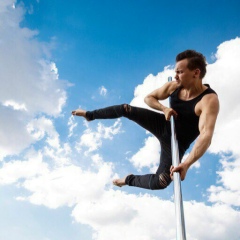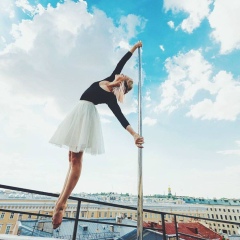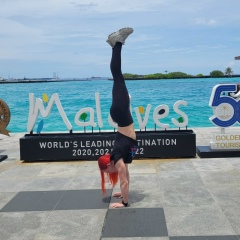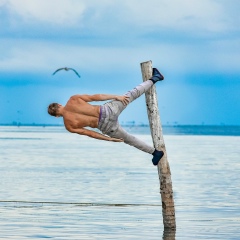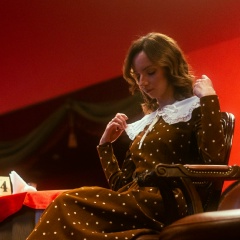Надо учить людей делать трюки хорошо, плохо они и сами могут научиться.
После каждого чемпионата по Pole Dance меня посещает такая мысль. Да что уж там после чемпионата, даже на воркшопах я порой слышу фразу "меня так научили". Показывают видео в инсте: "Смотри, что научилась. Немного грязновато правда."
А там не немного грязновато, там трюк, который при повторном исполнении дает дополнительные шансы слететь с шеста и придти на голову.
Я не хочу обижать людей, но разделив радость получившегося элемента лучше сразу работать над ошибками. Нет, не коленями и носками. Это вторичное, это не техника в большинстве случаев. А работать над всем другим: положением тела, плоскостями, отмашками, применением рычагов, зацепов, толчками, подъемами, входом в трюк, выходом и тд.
У меня ощущение, что иногда преподаватели куда-то торопятся на пару с учениками или бояться им указать на ошибки.
Следите за деталями, смотрите чуть дальше, на трюк до и трюк после. Это даст понять есть ли проблемы на входе и выходе. Лучше уметь немного, но правильно, чем уметь много и никак.
В связке трюков очень часто техника начинает потихоньку страдать, и чем сложнее и длиннее связка тем больше шансов запороть все, если с самого начала все испортить неправильной техникой.
Мне говорят: "Ты чего паришься? Чем больше плохих тренеров, тем выше твоя ценность".
А я в таком случае начинаю заниматься переучиванием людей, а не продолжаю их путь.
Это здорово, когда люди получают новые навыки и радуются этому вместе с преподавателем. Но одно из ценнейших качеств тренера будет сразу указать на ошибки ученика или свои, ну или уже сказать: "Я понятия не имею как делать этот трюк" и не заниматься ерундой.
Сознательные тренеры есть и это здорово, а когда тренер занимается с сознательными учениками, то это самый продуктивный союз.
После каждого чемпионата по Pole Dance меня посещает такая мысль. Да что уж там после чемпионата, даже на воркшопах я порой слышу фразу "меня так научили". Показывают видео в инсте: "Смотри, что научилась. Немного грязновато правда."
А там не немного грязновато, там трюк, который при повторном исполнении дает дополнительные шансы слететь с шеста и придти на голову.
Я не хочу обижать людей, но разделив радость получившегося элемента лучше сразу работать над ошибками. Нет, не коленями и носками. Это вторичное, это не техника в большинстве случаев. А работать над всем другим: положением тела, плоскостями, отмашками, применением рычагов, зацепов, толчками, подъемами, входом в трюк, выходом и тд.
У меня ощущение, что иногда преподаватели куда-то торопятся на пару с учениками или бояться им указать на ошибки.
Следите за деталями, смотрите чуть дальше, на трюк до и трюк после. Это даст понять есть ли проблемы на входе и выходе. Лучше уметь немного, но правильно, чем уметь много и никак.
В связке трюков очень часто техника начинает потихоньку страдать, и чем сложнее и длиннее связка тем больше шансов запороть все, если с самого начала все испортить неправильной техникой.
Мне говорят: "Ты чего паришься? Чем больше плохих тренеров, тем выше твоя ценность".
А я в таком случае начинаю заниматься переучиванием людей, а не продолжаю их путь.
Это здорово, когда люди получают новые навыки и радуются этому вместе с преподавателем. Но одно из ценнейших качеств тренера будет сразу указать на ошибки ученика или свои, ну или уже сказать: "Я понятия не имею как делать этот трюк" и не заниматься ерундой.
Сознательные тренеры есть и это здорово, а когда тренер занимается с сознательными учениками, то это самый продуктивный союз.
It is necessary to teach people to do tricks well, they themselves can learn badly.
After every Pole Dance championship I get this thought. Why, after the championship, even at workshops I sometimes hear the phrase "I was taught this way." They show a video on the insta: "Look what you learned. A little dirty truth."
And there is not a little dirty, there is a trick that, when repeated, gives additional chances to fly off the pole and come on your head.
I do not want to offend people, but sharing the joy of the resulting element is better to immediately work on the mistakes. No, not with knees and socks. This is secondary, it is not a technique in most cases. And work on everything else: body position, planes, signals, using levers, holds, pushing, lifting, entering a trick, exiting, etc.
I have a feeling that sometimes teachers are in a hurry for a couple with students or are afraid to point out mistakes to them.
Follow the details, look a little further, for the trick before and the trick after. This will let you know if there are problems entering and exiting. It is better to be able to a little, but correctly, than to be able to do a lot and in no way.
In a bundle of tricks, very often the technique begins to suffer slowly, and the more difficult and longer the bundle, the more chances to screw everything up, if from the very beginning everything is ruined by the wrong technique.
They say to me: "Why are you so worried? The more bad coaches, the higher your value."
And in this case, I begin to retrain people, and do not continue their path.
It's great when people learn new skills and enjoy it together with the teacher. But one of the most valuable qualities of a coach will immediately point out the student's mistakes or his own, or already say: "I have no idea how to do this trick" and not do nonsense.
There are conscientious coaches and this is great, and when a coach deals with conscientious students, then this is the most productive union.
After every Pole Dance championship I get this thought. Why, after the championship, even at workshops I sometimes hear the phrase "I was taught this way." They show a video on the insta: "Look what you learned. A little dirty truth."
And there is not a little dirty, there is a trick that, when repeated, gives additional chances to fly off the pole and come on your head.
I do not want to offend people, but sharing the joy of the resulting element is better to immediately work on the mistakes. No, not with knees and socks. This is secondary, it is not a technique in most cases. And work on everything else: body position, planes, signals, using levers, holds, pushing, lifting, entering a trick, exiting, etc.
I have a feeling that sometimes teachers are in a hurry for a couple with students or are afraid to point out mistakes to them.
Follow the details, look a little further, for the trick before and the trick after. This will let you know if there are problems entering and exiting. It is better to be able to a little, but correctly, than to be able to do a lot and in no way.
In a bundle of tricks, very often the technique begins to suffer slowly, and the more difficult and longer the bundle, the more chances to screw everything up, if from the very beginning everything is ruined by the wrong technique.
They say to me: "Why are you so worried? The more bad coaches, the higher your value."
And in this case, I begin to retrain people, and do not continue their path.
It's great when people learn new skills and enjoy it together with the teacher. But one of the most valuable qualities of a coach will immediately point out the student's mistakes or his own, or already say: "I have no idea how to do this trick" and not do nonsense.
There are conscientious coaches and this is great, and when a coach deals with conscientious students, then this is the most productive union.
У записи 75 лайков,
6 репостов.
6 репостов.
Эту запись оставил(а) на своей стене Владимир Карачунов

